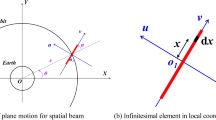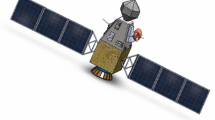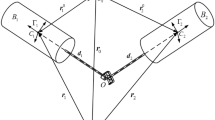Abstract
The dynamic analysis on the ultra-large spatial structure can be simplified drastically by ignoring the flexibility and damping of the structure. However, these simplifications will result in the erroneous estimate on the dynamic behaviors of the ultra-large spatial structure. Taking the spatial beam as an example, the minimum control energy defined by the difference between the initial total energy and the final total energy in the assumed stable attitude state of the beam is investigated by the structure-preserving method proposed in our previous studies in two cases: the spatial beam considering the flexibility as well as the damping effect, and the spatial beam ignoring both the flexibility and the damping effect. In the numerical experiments, the assumed simulation interval of three months is evaluated on whether or not it is long enough for the spatial flexible damping beam to arrive at the assumed stable attitude state. And then, taking the initial attitude angle and the initial attitude angle velocity as the independent variables, respectively, the minimum control energies of the mentioned two cases are investigated in detail. From the numerical results, the following conclusions can be obtained. With the fixed initial attitude angle velocity, the minimum control energy of the spatial flexible damping beam is higher than that of the spatial rigid beam when the initial attitude angle is close to or far away from the stable attitude state. With the fixed initial attitude angle, ignoring the flexibility and the damping effect will underestimate the minimum control energy of the spatial beam.




Similar content being viewed by others
References
Glaser PE. Power from the sun: its future. Science. 1968;162:857–61.
NASA, Final Proceedings of the Solar Power Satellite Program Review, DoE/NASA Conference 800491, 1980.
Mankins J. SPS-ALPHA: The First Practical Solar Power Satellite via Arbitrarily Large Phased Array, NASA NIAC Phase 1 Project, 2012.
Yin TT, Deng ZC, Hu WP, Wang XD. Dynamic modeling and simulation of deploying process for space solar power satellite receiver. Appl Math Mech—Engl Edit. 2018;39:261–74.
Yang Y, Zhang YQ, Duan BY, Wang DX, Li X. A novel design project for space solar power station (SSPS-OMEGA). Acta Astronaut. 2016;121:51–8.
Pao LY. Minimum-time control characteristics of flexible structures. J Guid Control Dyn. 1996;19:123–9.
Liu XD, Xin X, Li Z, Chen Z, Sheng YZ. Near minimum-time feedback attitude control with multiple saturation constraints for agile satellites. Chin J Aeronaut. 2016;29:722–37.
Zhu JM, Trelat E, Cerf M. Minimum time control of the rocket attitude reorientation associated with orbit dynamics. SIAM J Control Optim. 2016;54:391–422.
Eldad O, Lightsey EG, Claudel C. Minimum-time attitude control of deformable solar sails with model uncertainty. J Spacecr Rockets. 2017;54:863–70.
da Silva MRC, Zaretzky CL. Nonlinear dynamics of a flexible beam in a central gravitational field I. Equations of motion. Int J Solids Struct. 1993;30:2287–99.
da Silva MRC, Zaretzky CL. Nonlinear dynamics of a flexible beam in a central gravitational field II. Nonlinear motions in circular orbit. Int J Solids Struct. 1993;30:2301–16.
Chen ZQ, Agar TJA. Geometric nonlinear analysis of flexible spatial beam structures. Comput Struct. 1993;49:1083–94.
Quadrelli B, Atluri S. Analysis of flexible multibody systems with spatial beams using mixed variational principles. Int J Numer Methods Eng. 1998;42:1071–90.
Yang H, Hong JZ, Yu ZY. Dynamics modelling of a flexible hub-beam system with a tip mass. J Sound Vib. 2003;266:759–74.
Cai GP, Lim CW. Dynamics studies of a flexible hub-beam system with significant damping effect. J Sound Vib. 2008;318:1–17.
Zhang ZG, Qi ZH, Wu ZG, Fang HQ. A spatial Euler–Bernoulli beam element for rigid-flexible coupling dynamic analysis of flexible structures. Shock Vib. 2015;. https://doi.org/10.1155/2015/208127.
Yin TT, Deng ZC, Hu WP, Li QJ, Cao SS. Dynamic modelling and simulation of orbit and attitude coupling problems for structure combined of spatial rigid rods and spring. Chin J Theor Appl Mech. 2018;50:87–98.
Hu WP, Li QJ, Jiang XH, Deng ZC. Coupling dynamic behaviors of spatial flexible beam with weak damping. Int J Numer Methods Eng. 2017;111:660–75.
Hu WP, Deng ZC. Non-sphere perturbation on dynamic behaviors of spatial flexible damping beam. Acta Astronaut. 2018;152:196–200.
Hu WP, Deng ZC, Yin TT. Almost structure-preserving analysis for weakly linear damping nonlinear Schrödinger equation with periodic perturbation. Commun Nonlinear Sci Numer Simul. 2017;42:298–312.
Hu WP, Song MZ, Deng ZC, Yin TT, Wei BQ. Axial dynamic buckling analysis of embedded single-walled carbon nanotube by complex structure-preserving method. Appl Math Model. 2017;52:15–27.
Hu WP, Deng ZC, Wang B, Ouyang HJ. Chaos in an embedded single-walled carbon nanotube. Nonlinear Dyn. 2013;72:389–98.
Hu WP, Deng ZC, Han SM, Zhang WR. Generalized multi-symplectic integrators for a class of Hamiltonian nonlinear wave PDEs. J Comput Phys. 2013;235:394–406.
Hu WP, Song MZ, Deng ZC. Energy dissipation/transfer and stable attitude of spatial on-orbit tethered system. J Sound Vib. 2018;412:58–73.
Hu WP, Song MZ, Deng ZC, Zou HL, Wei BQ. Chaotic region of elastically restrained single-walled carbon nanotube. Chaos. 2017;27:023118.
Hu WP, Deng ZC. Chaos in embedded fluid-conveying single-walled carbon nanotube under transverse harmonic load series. Nonlinear Dyn. 2015;79:325–33.
Song G, Agrawal BN. Vibration suppression of flexible spacecraft during attitude control. Acta Astronaut. 2001;49:73–83.
Acknowledgements
The research is supported by the National Natural Science Foundation of China (11672241, 11972284, 11432010), Fund for Distinguished Young Scholars of Shaanxi Province (2019JC-29), Fund of the Youth Innovation Team of Shaanxi Universities, the Seed Foundation of Qian Xuesen Laboratory of Space Technology, and the Open Foundation of State Key Laboratory of Structural Analysis of Industrial Equipment (GZ1605).
Author information
Authors and Affiliations
Corresponding author
Rights and permissions
About this article
Cite this article
Hu, W., Yu, L. & Deng, Z. Minimum Control Energy of Spatial Beam with Assumed Attitude Adjustment Target. Acta Mech. Solida Sin. 33, 51–60 (2020). https://doi.org/10.1007/s10338-019-00132-4
Received:
Revised:
Accepted:
Published:
Issue Date:
DOI: https://doi.org/10.1007/s10338-019-00132-4




